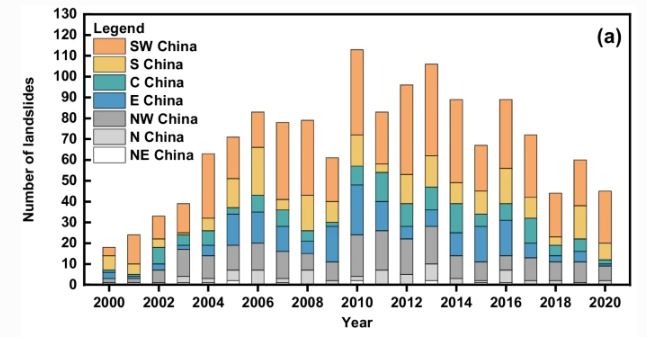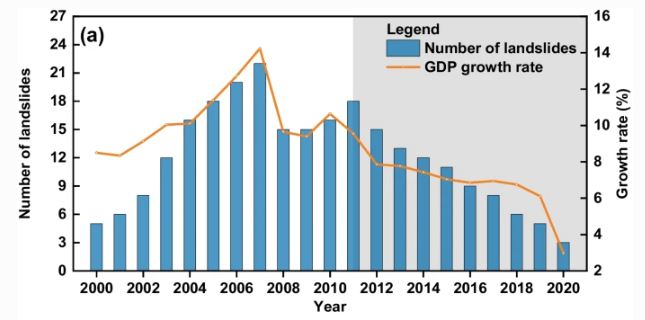16 March 2023
The relationship between GDP and fatal anthropogenic landslides in China
Posted by Dave Petley
The relationship between GDP and fatal anthropogenic landslides in China
One of the interesting observations Melanie Froude and I noted in our work on global fatal landslides (Froude and Petley 2018) was that the long term trend in China was surprising. In the early period of our work we saw a steady increase in the number of fatal landslides in China, but in the latter part of the study period we saw a decline. We were unsure as to how we could interpret this, in part because we did not know whether it was a real signal (reporting in China is controlled, so we thought it could be that the data was inconsistent).
A new study (Zhang et al. 2023) has compiled and analysed a dedicated fatal landslide database for China, which is really welcome. The research team is based in Zhejiang University, so the dataset is much more likely to be reliable. The study period was 1940 to 2020, although clearly the data quality for the early years of this period is inconsistent. As a result, there is a more detailed analysis of the period from 2000 to 2020.
Interestingly, like us the authors noted that fatal landslide occurrence is declining in China. Indeed, in their data there was a steady upward trend from 2000 to 2010, and a downward trend thereafter. This is the annual total, broken down by geographical region:-

The annual total number of fatal landslides in China, broken down by geographical region. from Zhang et al. (2023).
.
Understanding the cause of this change is extremely important. Zhang et al. (2023) have looked at this in some detail. One element is potentially explained in the graph below, from the paper, which shows the number of fatal anthropogenic landslides with time:-

The annual pattern of anthropogenic landslides and the growth of GDP with time in China. Graph from Zhang et al. (2023).
.
Here the peak is a little earlier (around 2007), and again the declining trend in the latter years is very clear. So, it appears that at least a part of the trend observed in China is due to a reduction in the number of anthropogenic landslides. But this is when it gets really interesting. The orange line on the graph is the growth in GDP for China. The similarity in trend between the number of fatal landslides and the GDP is remarkable (Zhang et al. 2023 have calculated the correlation coefficient to be 0.832). They explain this as follows:-
The years of rapid GDP growth were usually accompanied by a large number of human activities. These activities modified natural slopes through construction, mining, and quarries, among others, which greatly increased the risks of landslides.
So, it appears that in years of very rapid GDP growth, poorly controlled activities on slopes led to an increased number of fatal landslides. As GDP growth has slowed, the number of fatal anthropogenic landslides has also reduced.
I’m amazed by the strength of the correlation – it appears that GDP growth rate in effect switches fatal landslides on and off.
The authors are absolutely right to present the analysis, and their explanation, and this is an excellent piece of work. I’m left wondering though whether this relationship is real or one of those strange statistical artefacts that sometimes emerge. Can the cause and effect really be as strong as this? And does this apply elsewhere?
It’s a fascinating result that deserves further attention.
.
References
Froude, M. J. and Petley, D. N. 2018. Global fatal landslide occurrence from 2004 to 2016. Natural Hazards and Earth System Sciences, 18, 2161-2181, https://doi.org/10.5194/nhess-18-2161-2018.
Zhang, S., Li, C., Peng, J. et al. 2023. Fatal landslides in China from 1940 to 2020: occurrences and vulnerabilities. Landslides (2023). https://doi.org/10.1007/s10346-023-02034-6


 Dave Petley is the Vice-Chancellor of the University of Hull in the United Kingdom. His blog provides commentary and analysis of landslide events occurring worldwide, including the landslides themselves, latest research, and conferences and meetings.
Dave Petley is the Vice-Chancellor of the University of Hull in the United Kingdom. His blog provides commentary and analysis of landslide events occurring worldwide, including the landslides themselves, latest research, and conferences and meetings.
India? Although I suppose climate change effects would distort data. I noticed this recently, my lay-person’s info:
https://www.bbc.co.uk/news/world-asia-64753169